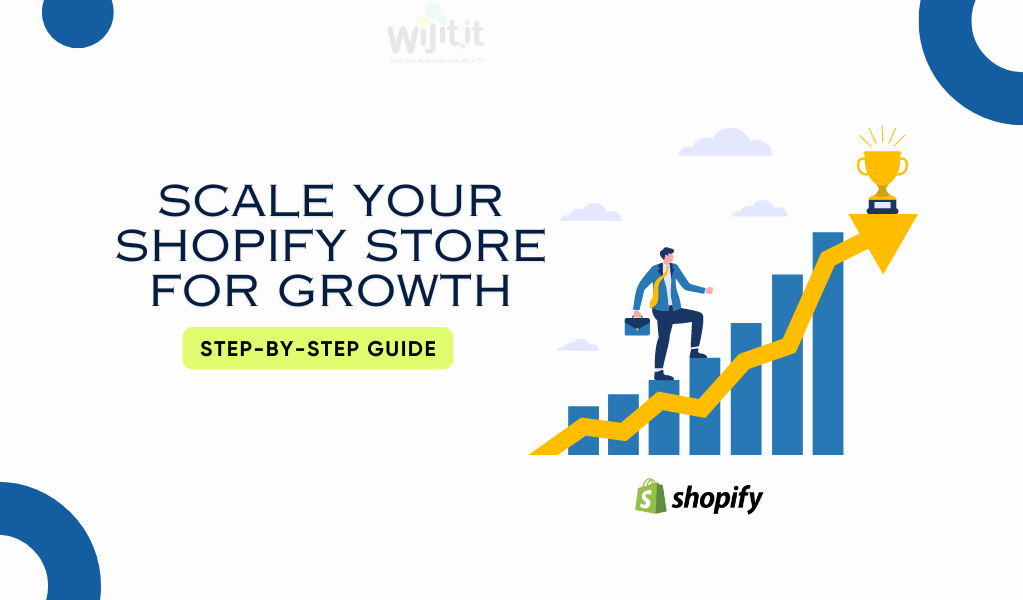
Scaling a Shopify store successfully requires more than just increasing traffic—it’s about building a sustainable framework that supports growth without sacrificing customer experience or operational efficiency.
Whether you’re a small business just starting or an established brand looking to expand, this guide will walk you through the key strategies to scale your Shopify store for growth.
Read Also : Shopify Speed Optimization — A Step-by-Step Guide
1. Optimize Your Website for Speed and Performance
A fast, well-performing website is the foundation of a scalable Shopify store. As traffic grows, slow load times and technical glitches can significantly affect conversion rates. Here’s how to ensure optimal performance:
- Use a Fast Theme: Choose a lightweight, well-coded theme optimized for speed, such as Shopify’s default themes or themes from reputable developers.
- Optimize Images: Use image compression tools like TinyPNG or Shopify’s built-in compression to reduce image sizes without compromising quality.
- Reduce App Bloat: Uninstall unnecessary apps, as they can slow down your store’s loading time. Only keep the apps essential for growth.
- Leverage Shopify CDN: Shopify offers a built-in Content Delivery Network (CDN) to ensure fast load times globally. Ensure it’s properly utilized.
2. Leverage Shopify Plus for Advanced Features
If you’re seeing rapid growth, it might be time to upgrade to Shopify Plus. The platform offers advanced features that can help you scale:
- Customizable Checkout: Shopify Plus allows you to tailor the checkout experience to maximize conversions.
- Automation Tools: Shopify Flow and Launchpad allow you to automate repetitive tasks like inventory management, customer segmentation, and promotions.
- Unlimited Staff Accounts: With Shopify Plus, you can delegate tasks and give different team members the appropriate level of access.
By leveraging these advanced features, you’ll be able to streamline operations and focus on growth.
3. Invest in Marketing Automation
Automating your marketing efforts will allow you to scale without increasing your marketing team’s workload. Here are some key areas where automation can make a big impact:
- Email Marketing: Tools like Klaviyo and Omnisend allow you to automate welcome emails, cart abandonment sequences, and post-purchase follow-ups.
- Customer Segmentation: Use automation to segment customers based on their behavior, allowing for personalized email campaigns and promotions.
- Loyalty Programs: Automate customer loyalty programs with apps like Smile.io, offering rewards for repeat purchases.
Read Also : How to Select the Best Shopify Apps 2024
4. Expand Your Sales Channels
As you grow, it’s crucial to diversify your sales channels. Shopify makes it easy to sell across multiple platforms, giving you access to new customers:
- Social Media: Integrate your Shopify store with Facebook, Instagram, and Pinterest for seamless social selling.
- Marketplaces: List your products on Amazon, eBay, and Walmart, using Shopify apps that synchronize your inventory and orders across platforms.
- Physical Stores: If you’re moving into brick-and-mortar retail, Shopify POS allows you to manage both your online and offline sales from a single dashboard.
5. Improve Customer Retention
While acquiring new customers is essential, retaining existing ones is more cost-effective and critical to scaling. Here’s how you can improve customer retention:
- Offer Exceptional Customer Service: Use Shopify apps like Gorgias or Zendesk to streamline customer service inquiries and resolve issues faster.
- Implement a Subscription Model: If applicable to your business, a subscription model can increase the lifetime value of your customers. Apps like Recharge or Bold Subscriptions integrate seamlessly with Shopify.
- Personalized Recommendations: Use AI-powered apps like LimeSpot or Nosto to show personalized product recommendations, increasing upsells and cross-sells.
Read Also : Shopify Customization: The Definitive Guide for Non-Coders
6. Focus on International Expansion
Expanding into new regions is an excellent way to scale. Shopify makes international selling easier with multi-currency and multi-language features. Here are a few things to consider:
- Localized Content: Translate your store into different languages with apps like Weglot or Langify. This will improve user experience for international customers.
- Global Payment Options: Shopify Payments, PayPal, and other local payment gateways make it easy for international customers to pay in their preferred currency.
- Shipping Solutions: Partner with international shipping providers like DHL or UPS, and offer real-time shipping rates at checkout.
7. Optimize for Mobile Commerce
More than 50% of online traffic comes from mobile devices, so ensuring your Shopify store is mobile-optimized is crucial for growth. Here’s how to optimize for mobile:
- Mobile-First Design: Ensure your Shopify theme is responsive and offers a great mobile user experience.
- Accelerated Mobile Pages (AMP): Use AMP to make your mobile pages load faster, improving SEO and user engagement.
- Mobile Payments: Enable mobile payment options like Apple Pay or Google Pay to make the checkout process more convenient for mobile users.
8. Invest in Data Analytics and Insights
Data-driven decisions are the key to scaling your store effectively. Shopify provides several analytics tools, but you should also integrate third-party analytics platforms to get a more in-depth understanding:
- Shopify Analytics: Use Shopify’s built-in analytics to track sales, traffic, and customer behavior.
- Google Analytics: Implement Google Analytics for more detailed insights into traffic sources, customer behavior, and site performance.
- Heatmaps: Use tools like Hotjar or Lucky Orange to see where customers click, how they scroll, and which sections of your site need improvement.
9. Outsource and Automate Logistics
As your Shopify store grows, fulfilling orders can become overwhelming. Outsourcing logistics and automating the fulfillment process can help you scale efficiently:
- Use a 3PL Provider: Partner with third-party logistics (3PL) providers like ShipBob or Fulfillment by Amazon (FBA) to handle warehousing and shipping.
- Automate Order Management: Shopify apps like ShipStation or OrderlyEmails can automate order confirmation, shipping updates, and tracking emails.
- Inventory Management: Ensure you have real-time inventory tracking with apps like TradeGecko or Stocky, preventing stockouts or overstocking.
Read Also : How To Add Color Swatches to Products in Shopify
10. Scale Your Team and Operations
As your business scales, so should your team. Focus on hiring key roles that can manage operations, marketing, and customer service. Here’s how to ensure smooth scaling of your operations:
- Hire for Specialized Roles: Consider hiring for roles like an operations manager, marketing expert, or customer service specialist as your business expands.
- Use Collaboration Tools: Tools like Slack, Asana, or Trello can help keep your growing team organized and ensure smooth communication.
Conclusion
Scaling your Shopify store is a challenging yet rewarding journey. By optimizing your site, leveraging automation, expanding sales channels, and improving customer retention, you can set the foundation for sustainable growth. Whether you’re just starting or already established, these strategies will help you scale your Shopify store to new heights.
Ready to scale your Shopify store? Implement these strategies today and watch your business grow exponentially!
